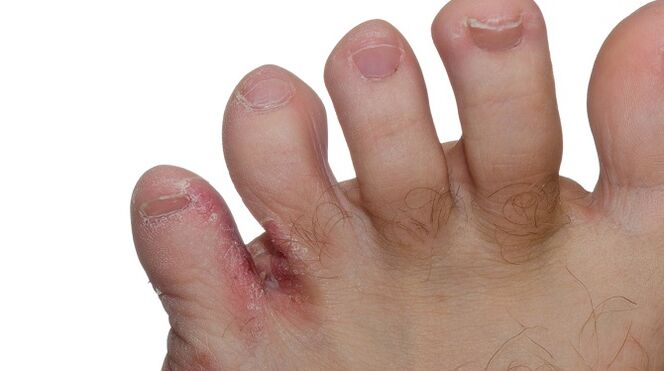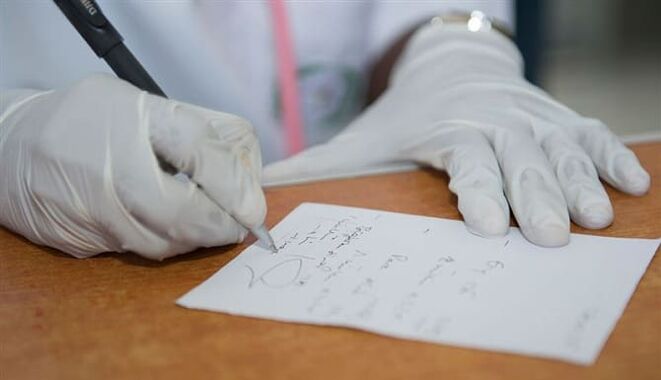Mycotic lesions of the skin and stratum corneum are extremely unpleasant. But these infections are quite common: omniscient statistics say that a fifth of humanity has experienced all the "charm" of becoming acquainted with them. A type of pathology is a fungus between the toes, which, without the necessary treatment, quickly spreads to thenails spreads. It will not be easy to deal with it, but relief is still possible. Complex therapy helps in the fight against the disease, but it must be carried out patiently and competently.
What is interdigital fungus on the feet and what does it look like?
Three types of fungi cause finger infections: molds, yeasts and dermatophytes. Each of them has their own preferences. Microorganisms from the mold family settle in the areas of the legs where it is warm and moist, so they usually appear where a similar lesion already exists. Yeast does not despise nails or skin. Dermatophytes are the most common causes of mycoses; Fungi on the thumb and interdigital pathology are their "specialization". What all species have in common is a preference for warmth and high humidity.
The symptoms of the fungus in the initial stages are quite mild. Suspicion may arise if the following signs are present:
- sudden cracks on the foot and toes, the medical history usually begins with the little toe;
- the skin around the cracks peels off;
- slight itching, which disappears without a trace after hygiene measures.
When the fungus begins to actively multiply, the symptoms can no longer be ignored: red spots appear, severe peeling, burning and itching are possible. The occurrence of bubbles in transparent contents cannot be ruled out. As the cracks deepen, they become erosions. The inflammatory process leads to tissue swelling.

If this period is neglected, the advanced stage of the fungus begins:
- Transparent blisters between the fingers turn into ulcers that burst and form sores.
- Itching, burning intensify, severe pain appears;
- Mycosis that has spread to the nails begins to destroy them.
It is no longer possible to ignore such symptoms. Going to the doctor is the only way to get well again.
Causes of interdigital mycosis
There is no shortage of victims of the fungus between the toes; on the contrary, the number of infected people is actually increasing. The reason for this sad picture is ignorance of the hygiene rules. Because these pathogens love high humidity and heat and their entry points are skin wounds, the risk increases when the following factors are present:
- Visiting public places where a person walks barefoot or uses other people's shoes, towels or washcloths;
- tight shoes leading to microtrauma;
- excessive sweating coupled with a negligent attitude to hygiene measures;
- reduced immunity;
- varicose veins;
- hormonal imbalance;
- Dysbiosis.
Risk of mycotic infection
Some people don't believe that athlete's foot is a serious problem. But this opinion is wrong. The greatest danger is the chronic form of the disease, which leads to nail damage, which in turn severely impairs the quality of life. A person with mycosis is a source of infection that can "reward" the whole family, and a fungus between the toes of a child or an elderly person is fraught with major health problems.
If the disease is left to chance, the body suffers from toxins that arise from the activity of fungi. In some cases, fungal infections trigger severe allergic reactions. Against the background of mycosis, immunity is suppressed, which is especially dangerous for children and the elderly. As a result, a "non-serious" disease leads to the invasion of many other infections - bacterial or viral in nature - with varying degrees of severity.
How to treat toe fungus
Not everyone can get rid of the fungus quickly, so it is better to prepare for a long battle in advance. Therapy is usually carried out at home, so you must first undergo an examination to identify the real culprit. After the diagnosis, the doctor (dermatologist or mycologist) will prescribe comprehensive treatment.
pills
An already advanced infection requires oral medication. This type of therapy uses effective antifungal tablets and capsules that help get rid of the plague quite quickly.
- Most often, the drug from the allylamine group is prescribed. He gets over the fungus on his finger in 3-4 weeks. The maximum daily dose is 250 mg.
- A triazole derivative is the next broad-spectrum drug. The intake is limited to two tablets per day. Completion of two two-week courses with a break of 21 days in between is required.
- The triazole group product is capsules that are used for a variety of skin diseases. The drug also helps against fungus on the feet between the toes. There are 2 options for taking it: either 50 mg once a day or 150 mg once a week, but immediately. The duration of therapy is 4-6 weeks.
Anoint
Oral medications must be supplemented with medications for external use - creams or ointments. They are the first answer to the question of how to get rid of toe fungus. Topical remedies are numerous and their costs vary.

All ointments are effective if one condition is met: the feet must first be steamed in a soap and soda solution and then dried thoroughly.
- The imidazole derivative is the leader of the sympathies of those who decided to destroy athlete's foot at home. The reason is efficiency and reasonable price. The drug is applied to clean fingers and nails 2-3 times a day. The duration of the course is individual and is controlled by a doctor. After symptoms disappear, it is recommended to continue treatment for at least two weeks.
- A product from the imidazole group is used twice a day, the duration of therapy is 4-6 weeks, but in advanced cases it is necessary to use the composition for several more days. If the fungus has spread to the nails, compresses are made from ointment.
- Creams from the allylamine group also belong to the category of external products. The active ingredient is the substance that gives the cream its name. The cream is applied 1-2 times a day; for affected feet, the application period is up to 4 weeks. If the nail plates are already affected by mycoses, it is recommended to treat the feet for 3 to 6 months.
The most important rule is the correctness of the procedures and compliance with the prescribed deadlines. In other cases, treatment may be ineffective.
bath
This folk treatment for fungus between toes at home will not take much time, but will give an effect if the stage of mycosis is easily curable.
- Coffee.For the process you will need ground coffee: 10 tbsp. l. Pour in 2 liters of boiling water. When the "drink" has cooled down, lower your feet into it. It is allowed to take coffee foot baths twice a day.
- Mugwort.To prepare it, take a liter of boiling water and 150 g of herbs. Prepare the stock in a water bath for 30 minutes. The duration of the procedure is at least half an hour.
- Boric acid- a well-known remedy for fungus between the fingers. For the bath, take 40 g of powder, which dissolves in water (50-60 ° C). There is no need to use the procedure too frequently; perform it 2-3 times a week.
- salt and soda.Pour warm water into a container and add 1 tbsp. l. sodium chloride and carbonate. Leave your feet in the bathtub for at least 15 minutes and then rinse them with water.
- Celandine.2 TBSP. l. Pour a liter of boiling water over the herbs, cover with a lid and wait until they cool to room temperature. The duration of the procedure should be at least a quarter of an hour.
These procedures do not always help and not everyone. This feature is not unique to folk methods. But that doesn't mean you should give up: there are many ways to cure a fungus between your fingers.
Compressed
This type of treatment is good because the medication stays on the affected areas for a long time, as many of them are recommended to be kept overnight. The following folk remedies are recommended in this category:
- Propolis.An alcohol tincture is used for the compress. Cotton is moistened in it, which is then fixed between the fingers. The procedures last a week and a half.
- Birch tar.Before applying the composition, the feet are well steamed and cleaned of dead skin. Dry feet are smeared with tar, and the space between the toes is treated particularly carefully. This compress is kept for at least an hour, then the excess tar is removed with a napkin. It is forbidden to wash your feet for 2 days. The total number of procedures is 4-5 times.
- Garliccrushed and then mixed with salt. Garlic compresses should not be left on for too long. The product is left for 1-2 hours.
- Ammonia.Take 1 tbsp per glass of water. l. A piece of gauze is then soaked in the solution and wrapped around the foot. A bag is placed on top and a sock on top of it. About 8-10 procedures need to be carried out.
- Onionjust as effective as garlic. Only in this case juice is used. The compresses are left overnight. If the skin between your fingers gets wet and a strong burning sensation bothers you, you can mix the juice with petroleum jelly in equal parts.
physical therapy
To be successful, the complex treatment of interdigital fungus on the feet also includes physiotherapeutic procedures:
- Ozone therapy.This procedure significantly accelerates the growth of a healthy nail when the disease is already very advanced. During the procedure, both the plate and the skin are saturated with ozone and oxygen, which stimulates nail growth while destroying the fungal infection. Not only fungi on the skin of the toes, but also absolutely all types of mycoses are successfully cured.
- Laser treatment.This process only destroys the cells in which the fungus has settled. The course of therapy includes 4-10 procedures. Preliminary preparation is not required, but parallel drug treatment is required.
diet
In order to successfully combat finger fungus, a change in diet is important.
Some foods in the diet must either be completely excluded or their consumption severely restricted. These include:
- alcoholic drinks;
- confectionery, flour products;
- fermented milk products containing sugar;
- Sweets;
- sausages;
- canned food;
- smoked meat;
- Meat;
- semi-finished products.
The following is allowed:
- cereals (only semolina and rice are excluded);
- Coffee;
- Dairy and fermented milk products without sugar;
- Seafood;
- vegetables, vegetables;
- nuts, seeds;
- Boiled fish;
- butter and vegetable oil;
- Tea;
- Eggs.
How to prevent the disease from recurring
In order for mycosis of the toes to disappear forever, you must adhere to the following rules:
- Wear shoes that fit your feet to avoid injuring your toes. It is better to give preference to natural materials. Frequent disinfection of shoes is required.
- After public places, the feet need preventive measures: they should be washed and lubricated with lemon juice, and the toes should be given a lot of attention.
- A daily change of socks is a must. It is better to opt for cotton products.
- It is forbidden to exchange shoes and bed linen or use other people's towels and pedicure items.
- Strengthening the immune system is a priority, so your diet should always include fruits, juices and vegetables.
To care for your skin and toenails, it is recommended to get a pedicure every month and a half.

















